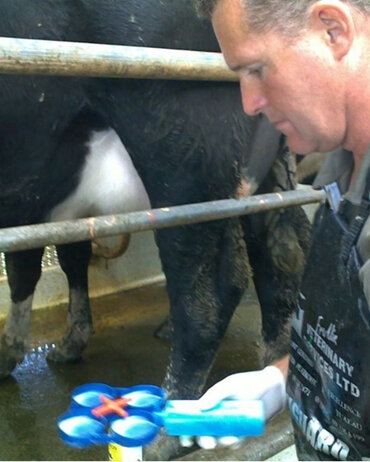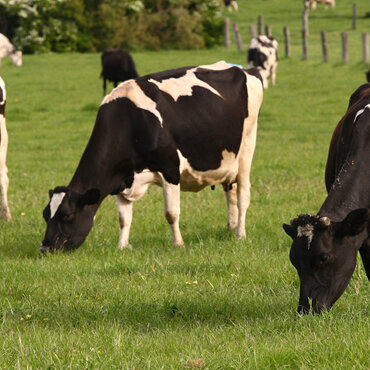Franklin Vets
Franklin Vets - excellence in veterinary care for dairy, farming, lifestyle, equine and household pets. BESTPRACTICE ACCREDITED NZ.

In the seasonal rush of dairying in springtime, mastitis is often another headache for busy farmers to grapple with, often on a daily basis. But the disease that is costing the dairy industry about $280 million a year¹ is no joyride for the cows suffering it either.
Mastitis is an inflammatory disease of the udder, combining all the aspects of pain, redness, swelling, heat, and loss of function, all or any of which humans would do their best to avoid, or at least ease with the use of pain killers.
Today that understanding of treatment extends to knowing livestock also experience pain, and with it the slowing, debilitating effects it can bring when recovering from the disease or condition causing it.
Research in calves for example has shown the duration of pain experienced can be significantly greater than the procedure itself, and impact on their ability to recover from it as quickly.
Farmers’ and veterinarians’ approach to managing pain has changed in the past decade, partly thanks to greater research into the subject. Research work has delved deeper into species that tend to hide their discomfort, such as cattle, to better understand the extent of their pain experience and the impacts on production.
A 2011 survey of New Zealand vets’ perception of pain caused by mastitis highlighted this. Vets ranked ‘mild’ mastitis pain as a “3” out of 10, while severe was rated at a high “8”.
But it is farmers who are most often at the sharp end of mastitis detection.
Farmers’ recognition of mastitis in a cow typically has that cow processed in a routine of diagnostics and treatment, as well as withholding of milk until any antibiotics (if required) have cleared their withholding period.

But thanks in part to New Zealand’s world-leading animal welfare standards, and a greater understanding among farmers of livestock pain, there is a growing awareness a standard antibiotic treatment alone for mastitis may no longer be sufficient.
More farmers now appreciate a cow’s experience is similar to humans and want the journey to good health to be less arduous. Ultimately, they want her to be as comfortable and productive as she was before contracting mastitis.
Anti-inflammatory, pain relief is increasingly being added to farmers’ treatment regime when dealing with seasonal mastitis.
In a simple shot, 72-hour s relief in helping ease the condition’s inflammatory pain is given.
This same long-acting anti-inflammatory pain relief has proven to deliver lasting, effective relief to animals coping with pain from essential treatments like debudding, surgical procedures, or diseases such as mastitis and calf scours.
Brookby farmer Dave Ritchie can attest to the effectiveness and humaneness of using it in his mastitis treatment regime.
“We started using long-acting anti-inflammatory pain relief two years ago. I would see cows come in with mastitis, clearly so sore with red, hot, swollen udders, walking in pain.”
As standard practice, Dave now reaches for it at the same time as an antibiotic mastitis treatment when isolating infected cows.
“We had used it before when we were debudding our calves and they always seemed to recover quickly. It’s just like people really - we would all reach for a Panadol if we were feeling sore or not well. No one likes to experience pain and I don’t like to see my cows experience it.”
Dave says after 24 hours the cows he has treated will often appear much more settled, walking more evenly, grazing, and on the way to a happier recovery.
He agrees farmers don’t always link mastitis with pain relief, but says the “one shot” with only 84 hours of withholding fits well with typical mastitis antibiotic treatment routines.
“I believe we get better antibiotic response as a result too. So, you don’t get compromised cow recovery where she may recover, but she still ends up with a light quarter afterwards.”
With antibiotic resistance a major concern in the production animal sector globally, the ability to ensure a single course of antibiotic treatment does its job first time thanks to th pain relief addition brings an assuredness the treatment is not contributing to excess use of these critical drugs.
His experience is backed by research showing long-acting anti-inflammatory pain relief treated cows experience a 32% improvement in mastitis cure when treated alongside antibiotics, compared to those not receiving.
It helps farmers fulfil some of the more holistic demands they face from today’s consumers expectations for how they look after their animals and their land.
It gives them the confidence they are meeting those demands, but more importantly fulfils every farmers’ belief that happy cows will ultimately be more productive cows. It helps ensure their journey to recovery is far more comfortable than it would ever be otherwise.”